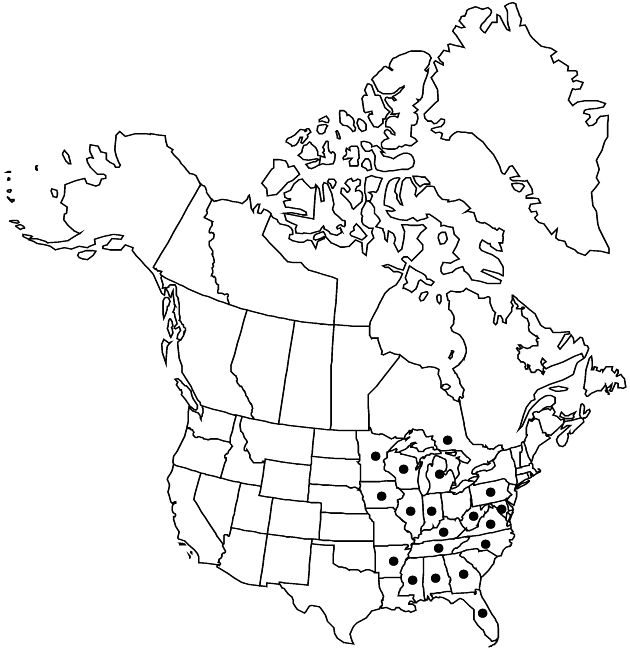Symphyotrichum shortii
Phytologia 77: 291. 1995.
Perennials, 30–150 cm, cespitose; short-rhizomatous or with ± woody caudices. Stems 1–5+, ascending to erect (straight, sometimes stout), proximally glabrous, distally ± densely hirtellous. Leaves thin, margins often slightly revolute, scabrous, apices mucronate or mucronulate, abaxial faces sparsely to moderately hispid, especially along veins, adaxial glabrous (midveins scabrous, veins marked) to strigoso-hispid (basal); basal withering by flowering (new winter rosette sometimes developing), petiolate (petioles 1–2 times as long as blades, sometimes narrowly winged, sheathing, densely pilose or hirsute), blades ovate to lance-ovate, 10–60 × 10–35 mm, deeply to shallowly cordate or rounded, margins crenate or crenate-serrate, apices obtuse to acute; proximal cauline mostly persistent, narrowly petiolate (petioles slender, progressively reduced distally, bases at most slightly clasping), blades ovate to lanceolate, 50–150 × 20–60(–70) mm, progressively reduced distally, bases shallowly cordate to subcordate, truncate, or rounded, sometimes oblique, margins entire, scabrous or shallowly crenate-serrate (proximal), apices acute to acuminate; distal short-petiolate (petioles sometimes narrowly winged, sometimes slightly clasping) or sessile (distalmost, rameal), blades ovate to lanceolate (rameal lance-linear to linear, sharply smaller), 8–80 × 1–40 mm, gradually reduced distally, bases rounded to cuneate or attenuate, margins entire to subentire, apices acute to acuminate. Heads usually in open, diffuse to narrow, paniculiform arrays, sometimes racemiform, branches widely spreading, usually divaricate to arching, sometimes ascending, sometimes ± secund, abundantly leafy. Peduncles 0.2–3(–5) cm, densely hirtellous, bracts 3–10+, ovate or lanceolate to subulate, grading into phyllaries. Involucres cylindro-campanulate, 4–6 mm. Phyllaries in 4–5(–6) series, appressed, lanceolate or oblong-lanceolate (outer) to linear-lanceolate or linear (inner), strongly unequal, bases indurate 1/2–5/6, margins scarious, erose, hyaline, ciliolate, green zones lanceolate to diamond-shaped (midveins below green zone sometimes inflated and brownish), apices acute to acuminate, often involute, mucronulate, faces strigilloso-hirsutulous. Ray florets 13–15(–20); corollas usually blue or purple-blue, seldom pinkish or white, laminae (10–)11–16 × 1.3–3.1 mm. Disc florets 16–23(–28?); corollas light yellow becoming reddish purple, 4.6–7 mm, tubes shorter than funnelform throats, lobes lanceolate, 0.4–1.1 mm. Cypselae dull purple or brown, oblong-obovoid, compressed, 2.5–3.7 mm, 4–7-nerved, faces glabrous; pappi reddish brown, tawny, or rose-tinged, 4–6.2 mm. 2n = 16, 32.
Phenology: Flowering Aug–Oct.
Habitat: Open, often thin, rocky, well-drained soils, oak-hickory woods, edges of woods, thickets, calcareous hammocks, wooded stream banks or cliffs, roadsides
Elevation: 100–500 m
Distribution

Ont., Ala., Ark., Fla., Ga., Ill., Ind., Iowa, Ky., Md., Mich., Minn., Miss., N.C., Pa., Tenn., Va., W.Va., Wis.
Discussion
Symphyotrichum shortii is of conservation concern along the whole periphery of its range, notably in Canada; there is a report from the District of Columbia but the species is not established there. Aster shortii Lindley forma gronemannii Benke is a roseate phenotype, and forma candidus Benke a white one, forma shortii being the normal blue or purple one. They are not recognized here.
Selected References
None.